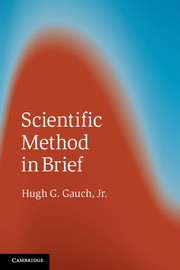Book contents
- Frontmatter
- Contents
- Foreword
- Preface
- 1 Introduction
- 2 Four bold claims
- 3 A brief history of truth
- 4 Science's contested rationality
- 5 Science's presuppositions
- 6 Science's powers and limits
- 7 Deductive logic
- 8 Probability
- 9 Inductive logic and statistics
- 10 Parsimony and efficiency
- 11 Case studies
- 12 Ethics and responsibilities
- 13 Science education
- 14 Conclusions
- References
- Index
8 - Probability
Published online by Cambridge University Press: 05 November 2012
- Frontmatter
- Contents
- Foreword
- Preface
- 1 Introduction
- 2 Four bold claims
- 3 A brief history of truth
- 4 Science's contested rationality
- 5 Science's presuppositions
- 6 Science's powers and limits
- 7 Deductive logic
- 8 Probability
- 9 Inductive logic and statistics
- 10 Parsimony and efficiency
- 11 Case studies
- 12 Ethics and responsibilities
- 13 Science education
- 14 Conclusions
- References
- Index
Summary
Suppose the Smiths tell you that they have two children and show you the family photograph in Figure 8.1. One child is plainly a girl, but the other is obscured by being behind a dog so that its gender is not apparent. What is the probability that the other child is also a girl? This probability question might seem quite simple. But the fact that this problem appeared in the pages of Scientific American is a hint that it might actually be tricky (Stewart 1996). Later in this chapter, this problem will be solved, but for now, just remember your initial answer for comparison with the correct solution.
Probability is the branch of deductive logic that deals with uncertainty. Logic occupies three chapters in this book on scientific method, with this chapter being the middle one. The previous chapter concerned other branches of deductive logic: propositional logic, predicate logic, and arithmetic. The next chapter concerns inductive logic, also called statistics. Recall that the PEL model identifies three inputs needed to reach any scientific conclusions: presuppositions, evidence, and logic. Accordingly, science needs functional deductive and inductive logic.
Information
- Type
- Chapter
- Information
- Scientific Method in Brief , pp. 131 - 149Publisher: Cambridge University PressPrint publication year: 2012
